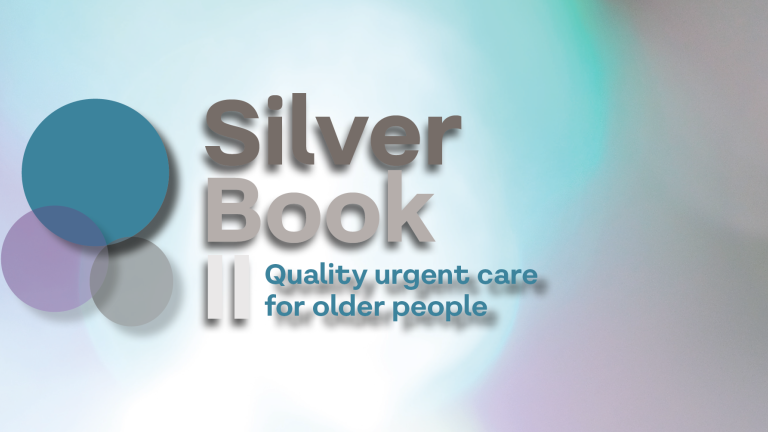Silver Book: quality care for older people with urgent and emergency care needs
|
This page refers to the 2012 edition of the Silver Book. An updated edition, Silver Book II, was released in February 2021. |
More older people than ever before are attending emergency departments and accessing urgent care services. There is a pressing need to address how older people are cared for over the first 24 hours of an urgent care episode. Attending an Emergency Department is associated with a high risk of admission for older people. Not only are older people admitted to hospital more frequently but they stay in hospital longer than other patient groups.
The Silver Book recommends ways in which emergency admissions can be reduced and the experience of those admitted improved. It considers all the clinical contacts which a patient might have during an emergency and suggests minimum standards and responses for each service including: primary care – in and out of hours; ambulance services; emergency departments; urgent care units – including minor injury units and walk-in-centres; acute medical units and community hospitals.
You can download both the complete Silver Book and the short version from this page.
Executive summary
Despite the majority of urgent care being delivered in the primary care setting, an increasing number of older people are attending emergency departments and accessing urgent health and social care services. This is partly related to the demographic shift that has resulted in a rapid increase in the number of older people, but may also be due to lower thresholds for accessing urgent care. Over the next 20 years, the number of people aged 85 and over is set to increase by two-thirds, compared with a 10 per cent growth in the overall population. Recent national reports including from Patient UK, Care Quality Commission, NCEPOD and the Health Service Ombudsman highlighted major deficiencies in the care of older people in acute hospitals ranging from issues around privacy and dignity to peri-operative care. Older people are admitted to hospital more frequently, have longer length of stay and occupy more bed days in acute hospitals compared to other individual groups. There is a pressing need to change how we care for older people with urgent care needs, to improve quality, outcomes and efficiency. Emergency departments need to be supported to deliver the right care for these people, as no one component of the health and social care systems can manage this challenge in isolation; implementation of improved care for older people requires a whole system approach.
Reducing the need for secondary care
Important factors in primary care that impact on the use of urgent care services include a timely primary care response and ready access to general practitioners. More community based services with a rapid response time may reduce the need to access secondary care. There needs to be better communication between ‘inhours’ and out of hours services. The ambulance service has a key role to play and can be an important contributor in doing things differently – for example, referring non-conveyed individuals directly to urgent care, community and primary care services, including falls services.
Attendance at the emergency department is associated with a high risk of admission for older people, and the nature of the service and the environment in which it is provided needs to change to reflect the changing nature of health care in the 21st century, the bulk of which relates to older people, and increasingly frail older people. Dedicated teams delivering comprehensive geriatric assessment can support this, but in themselves are not sufficient to realise whole system change. Services in all settings including health and social care need to improve their communication and handover, and greater use of the voluntary sector is to be encouraged. In acute medical units, greater use of geriatric liaison services should increase the proportion of older people able to be managed in the community setting.
In all settings, staff need to develop their understanding and confidence in managing common frailty syndromes, such as confusion, falls and polypharmacy as well as issues such as safeguarding in older people. These syndromes are commonly overlooked, but attention to these has the potential to greatly improve outcomes. There needs to be greater working across disciplines, both between professions (e.g. social care, physiotherapy and occupational therapy) and within professions (e.g. geriatricians working closely with emergency physicians).
Finally, commissioning evidence based integrated health and social care systems that address care across the continuum will help deliver safe, efficient, effective and a high quality holistic care for frail older people in the years to come.
